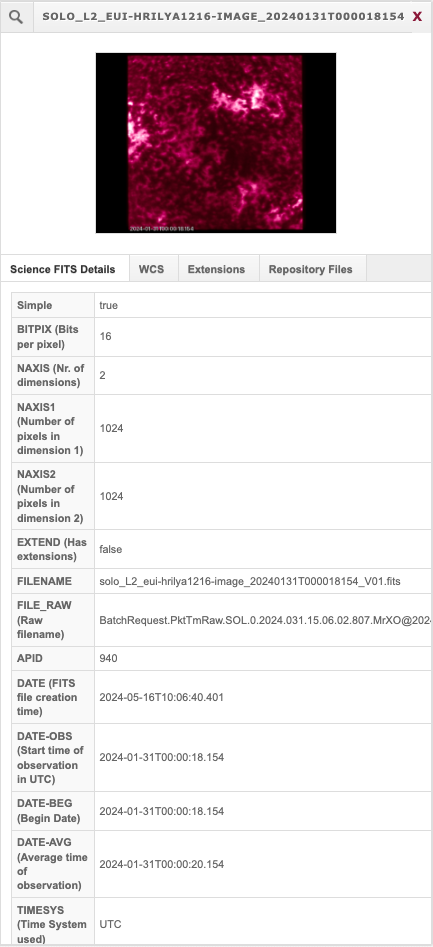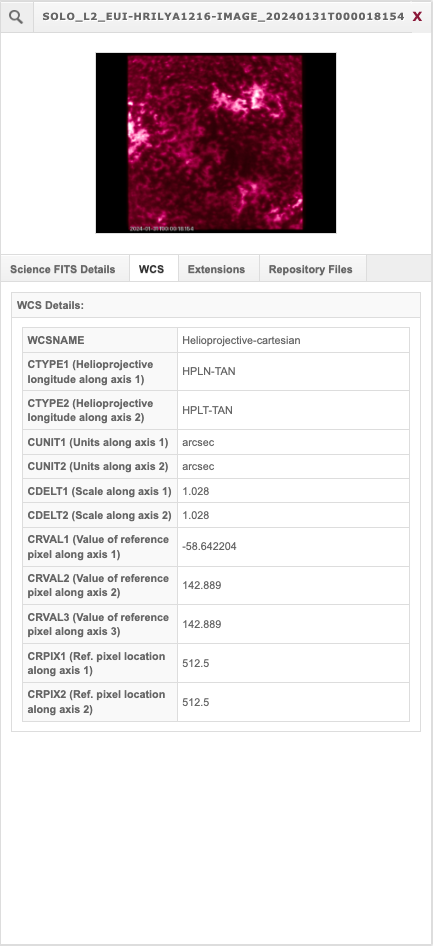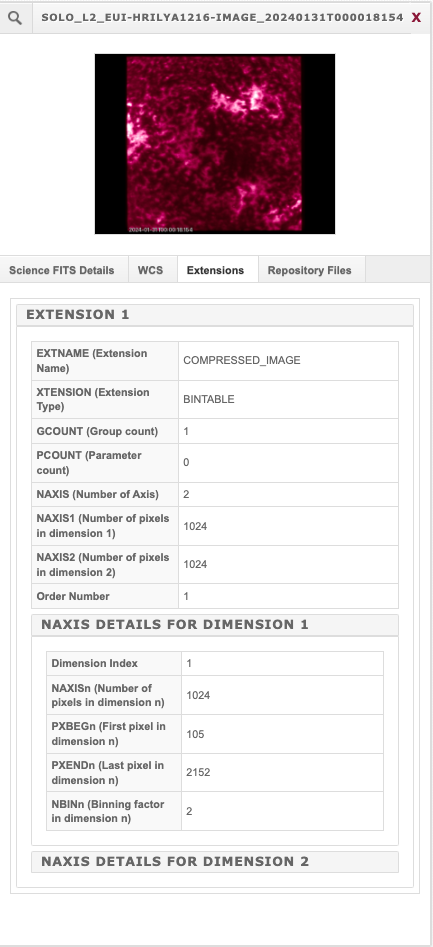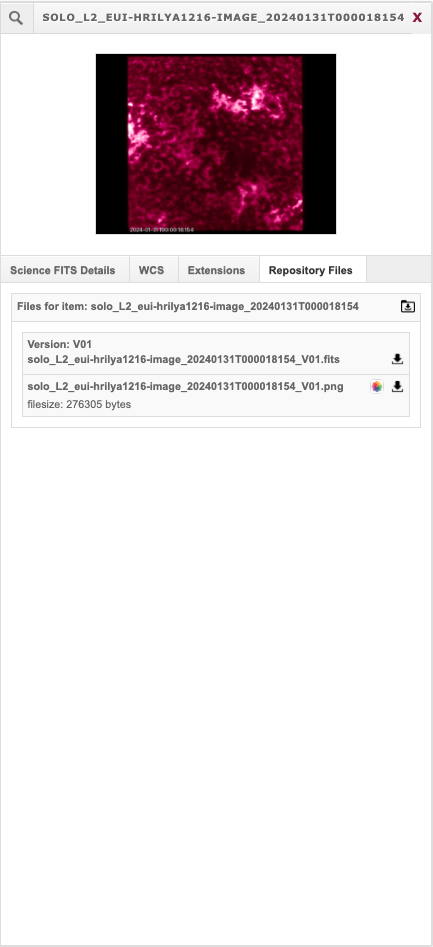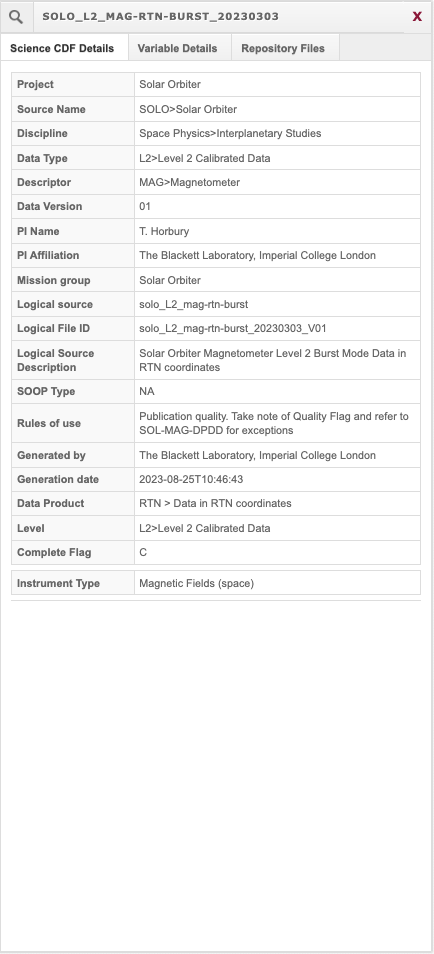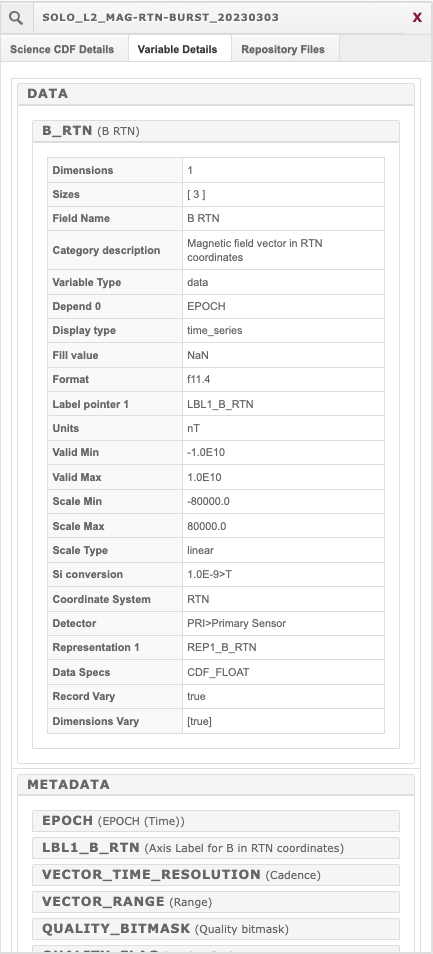Web Interface User Guide - Solar Orbiter Archive
SOAR WEB INTERFACE USer Guide
Welcome to the User Guide for the Solar Orbiter ARchive (SOAR) data search and download site. This guide will provide step-by-step instructions on how to use our graphical user interface (GUI) as well as alternative methods for accessing data via URLs and Python code.
Contents
Navigating the SOAR web interface
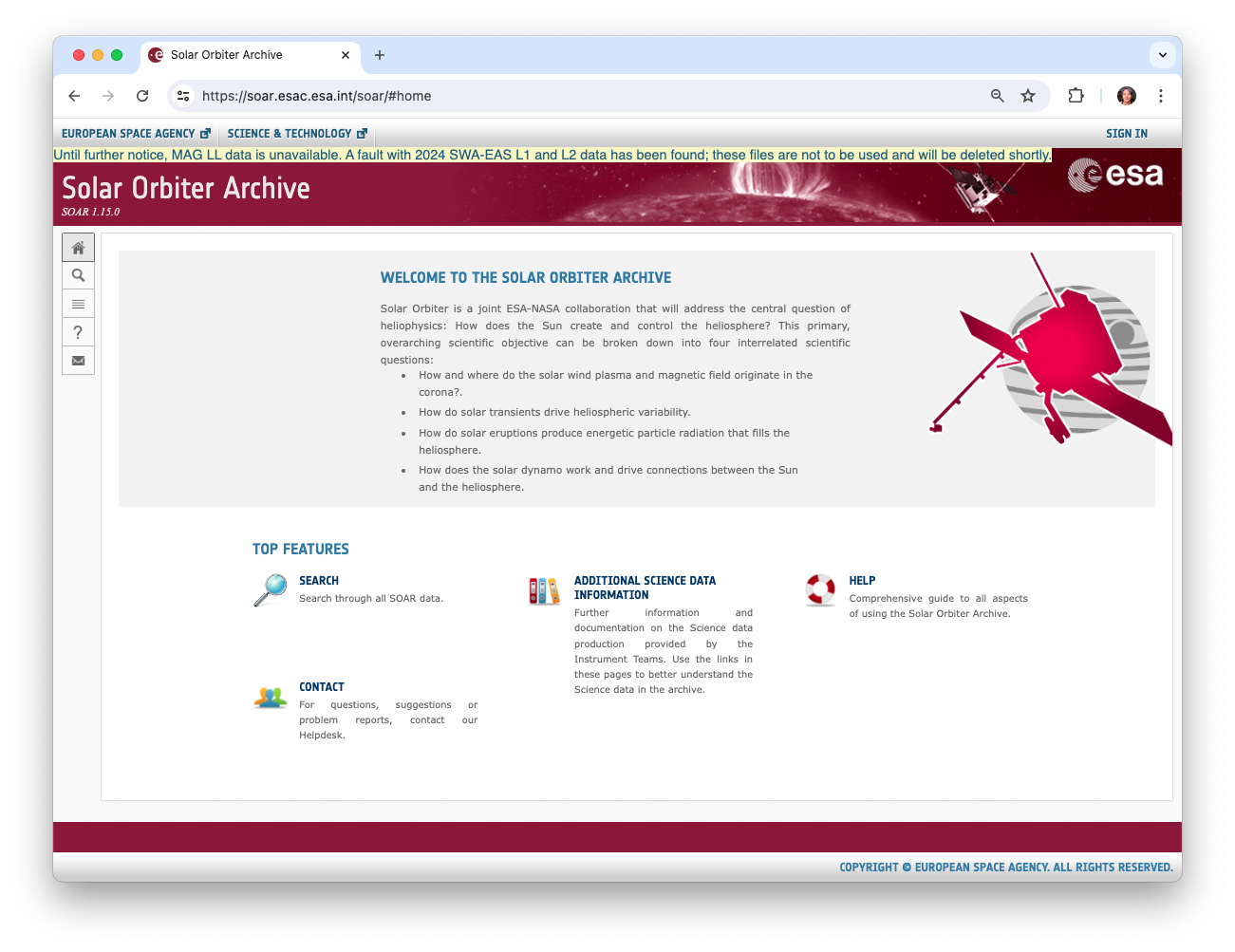
The main home page has buttons down the left for Home, Search, Results, Help, and Contact. The links at the bottom lead to the Search tab, the Contact tab, a page for Support Data (on this help site) and to the Help tab.
Search Panels

The Data Search box is divided into two tabs: SCIENCE and AUXILIARY (link to anchor).
- Search fields: see below
- Beneath the Search box are links to
- And the Search and Clear buttons to start the search or to clear all the criteria, resp.
Note that by default, each field is set to 'All', and so an empty search will return all the latest active files.
SCIENCE:
- Search Fields: from the SCIENCE search tab, the fields are:
- Time
- Start and end time in ISO format. Using the calendar button on the right of each box will give the date, then the time by default will be that date with the time 00:00:00 for the ‘from’ box and the same day with the time 23:59:59 for the ‘to’ box. Leaving them empty will return all available results.
- Instrument
- Dropdown box to select one or more instruments, or leave as ‘All’
- Processing Level
- This refers to the Processing level of each file, where L0 is only decommutated telemetry, L1 has been given engineering units, and L2 is calibrated data - L2 is the only one that should be used for science.
- File Name
- Any text can be put into this box and will be treated as a case-insensitive text search with wildcards (*) either end (? can be used as a single character wildcard) of all the filenames, e.g., ‘HRI’ or ‘swa-eas-padc_20220925T052734’
- SOOP Name/Type
- All Solar Orbiter Observing Plans (SOOPs) are given a long name and a short name (type). This dropdown box will allow one SOOP to be chosen and all data returned will have been observed during that interval. See SOAR Help SOOP page for a list of SOOPs and times, or the SOC’s SOOP pages for full details.
- Solar Distance
- Restrict the results to time intervals when the spacecraft was between these distances (in AU). If these boxes are left alone, they will not feature in the search.
- Include also:
- Low Latency: essentially quick-look files, once this box is ticked, the search will extend to these other processing levels - the extended list will now appear in the Processing Level dropdown box.
- Inactive files: some files have been made inactive because their filenames (usually descriptors) have been updated. The inactive file remains for reproducibility, but the file will no longer appear by default.
- Time
AUXILIARY

- Search Fields: from the AUXILIARY search tab, the fields are:
- Time
- Start and end time in ISO format. Using the calendar button on the right of each box will give the date, then the time by default will be 00:00:00 for the ‘from’ box and 23:59:59 for the ‘to’ box. Leaving them empty will return all available results.
- File Name
- Any text can be put into this box and will be treated as a case-insensitive text search with wildcards (*) either end (? can be used as a single character wildcard) of all the filenames, e.g., ‘soc-kernels-complete_V???_20200624’
- Include
- Spice Kernels - currently this is not a tickbox since only Spice kernels are offered at this time.
- Time
Results Display

The top tab (”RESULTS #1”) will show the search criteria when hovering the mouse over it, so subsequent searches can be made and the criteria are kept (this shows the pop-up for this search):
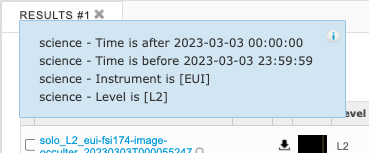
At the top of the table, the number of results is available in the black box
Download buttons: to the top right are two buttons: “Download selected” and “Download all”. The selection applies to the tickboxes on the left of the Results table, see below.

- Tickbox
- Tick the box to select the file/product. Those selected can then be downloaded with the “Download selected” button.
- Item Id
- The item ID, or ‘data_item_id’ (see table access) refers to each individual product, and is the main identifier of the product.
- Download icon
- The single file can be downloaded directly with this icon.
- Quick looks: Icons, Thumbnails, Postcards
- If available (currently EUI L2 products), an icon will show that this product has a quick-look image. Hovering over the icon will show a larger version (the ‘thumbnail’) and then clicking on it will reveal the postcard. This postcard is in .png format and can be downloaded, but it is only meant as a representation of the data and each postcard uses the full dynamic range of the image (so no good for a movie) and of limited resolution. The postcard can also be sent to other applications via SAMP using the icon in the top right. See screenshots below.
- Level
- I.e., Processing level, as explained for the Search box.
- Descriptor
- This is the identifier of the type of data in the product.
- Begin time
- Time at the start of the observation, in ISO format, as given in the filename and the internal metadata (DATE-BEG).
- End time
- Time of the end of the observation, as given in the filename (if provided), in the internal metadata (if provided), or in the case of FITS files and DATE-END is not provided, it is calculated from the start time (DATE-BEG) and the centre time (DATE-AVG).
- Instrument
- The main instrument name.
- Sensor
- If a separate sensor exists (depends on the processing level, e.g., inboard sensor (IBS) and outboard sensor (OBS) are available at L1, but not L2) it will be given here.
- File size
- Archived on
- Date that the file was ingested into the archive.
Note that there are 5 different buttons to download data:
- The 'Download selected' and 'Download All' buttons that are pictured above,
- The download icon in the Results table row
- Plus 2 more buttons in the 'Repository Files' tab of the metadata view (see below), one for all the versions of that file and others for each version individually.
Quick look images
The EUI L2 (fully processed data) results come with a series of images as quicklooks: smallest 'icons' in the results table rows - hover over this to display a slightly larger 'thumbnail':
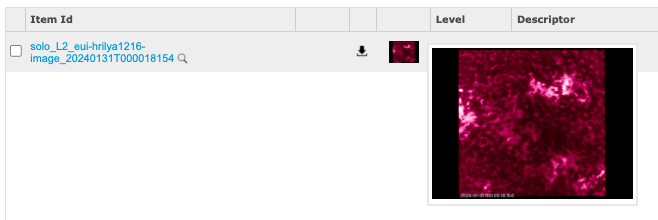
and clicking on this will bring up a larger 'postcard' which can be downloaded as a PNG or sent via SAMP to other applications. Note that the quality of this quick look image is not of publication quality, and all use the full range of brightness from each individual file, and so not suitable for assembling a movie. Please use the L3 JP2 files for the consistent dynamic range.
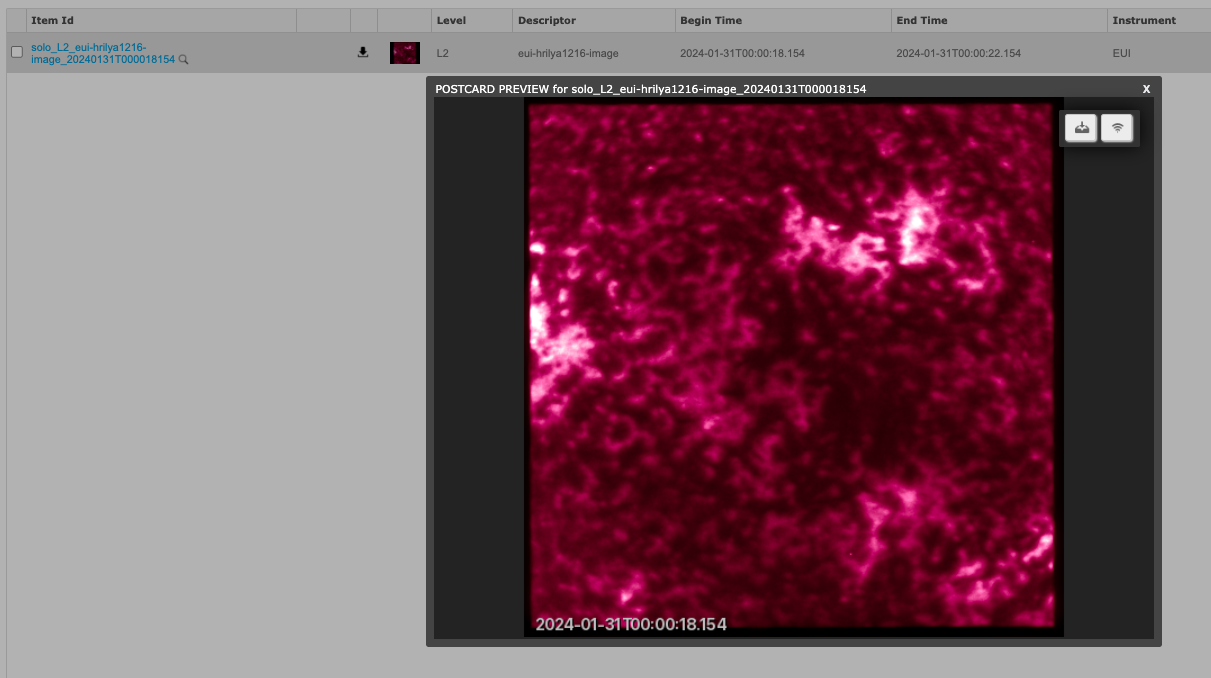
Metadata Display
If the filename in the Results table is blue, then the metadata is available to view. Click the filename and the metadata tables will be displayed on the right hand side:
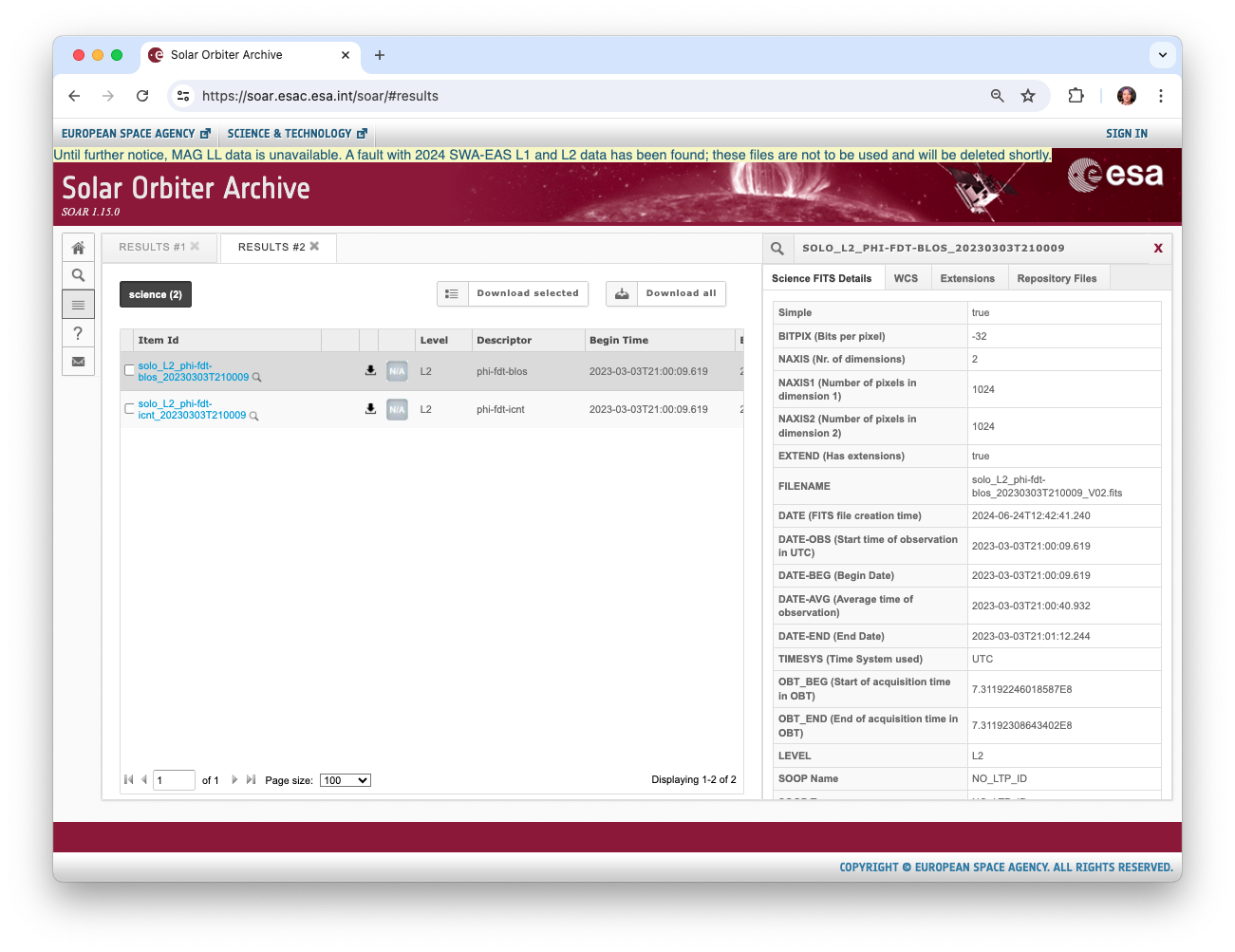
The tables available are slightly different for FITS and CDF, and whether the FITS comes with a set of quick look images or not (e.g., see PHI file above with no images, and our example EUI HRILYA1216 image below):
This tab gives details of the versions of the file that is held by the SOAR.
Note that not all version numbers may have been uploaded, but the highest version number will be the one available from the Results Table.
On the top line, 'Files for item' refers to the data item ID (data_item_id in the TAP tables) and the icon to the right enables the download of all versions of the data item and the postcards (if available).
The download icons beside each version and each postcard enable the download of just that item.









































 Sign in
Sign in
 Science & Technology
Science & Technology

